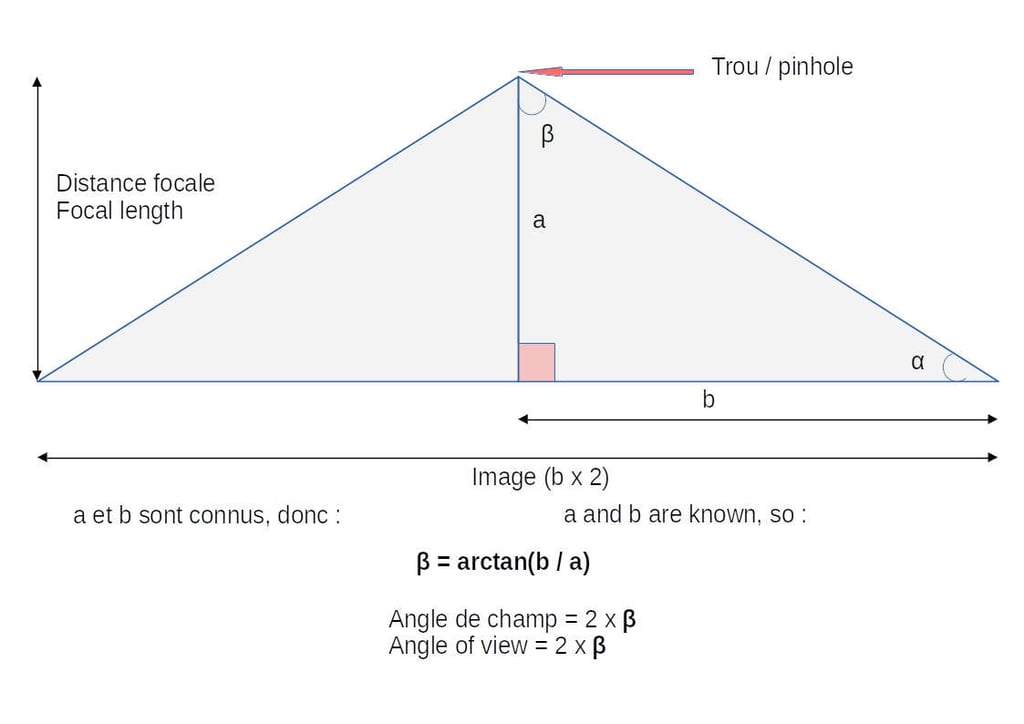What lens equivalent is a pinhole camera?
What is lens equivalent 35 mm of a pinhole camera? In other words what is the angle of view of a pinhole camera?
First of all, why is it still 35mm which is considered the standard in photography when most sensors, except those defined as "full format" have different sizes and film cameras have existed and still exist who use the 120 format (6x6, 6x12 etc)? Quite simply because it was, at the time of film, the most widespread format in the world. Even motion pictures used it. Analogue film manufacturing laboratories could supply both film studios and photographers, amateurs or professionals. Such mass production made it possible to provide film at an attractive cost. Yes, the old uncle who took photos at family reunions can thank Hollywood ;-)
So let's calculate this with paper sizes that I usually use: 18x24, 24x30 and their halves, 12x18, 9x24 and 12x30. Everything that follows is in centimeters unless otherwise stated. I am only talking here about the papers I use but with the formula it will be easy for you to apply it to the formats you use.
Let's first look at what is defined as a standard lens. It is simply the diagonal of the sensitive format. For a 135 film (35 mm, 24x36 mm), the theoretical standard is therefore 43 mm, hence the 45 or 50 mm focal length lenses on this format which are considered as the standard lenses, those which best correspond to our usual vision. The more you decrease the focal length and the more you feel like you're moving away from the subject, the more you increase the focal length and the more you feel like you're getting closer to it. A 28mm focal length lens is defined as a wide angle and a 300mm lens is a telephoto lens. A telephoto lens "grows" when a wide angle "shrinks". A wide angle is perfect for a landscape and a telephoto lens will be perfect for obtaining details invisible or almost invisible to the naked eye, the equivalent of binoculars for a camera. But since we are talking about diagonal and we use large format paper in pinhole cameras, the standard focal length changes. With 24x30 we obtain 38.41 centimeters. This means that a standard focal length on a 24x30 pinhole would be more than 380 mm when it is only 45 mm for a 24x36. It is the size of the sensitive surface which defines the standard focal length, nothing else. A 300mm lens is a nice telephoto lens on a 24x36 but 300mm "focal length" on a 24x30 pinhole is a wide angle. This means that 45mm focal length for a camera equipped with 135 film will have approximately the same image as a pinhole camera with 380mm focal length. What defines a wide angle is any focal length less than the diagonal of the sensitive format. It goes from normal wide angle to super or even ultra wide angle.
After this (long) introduction let's move on to practice.
Since what interests us above all is what enters the photo I will only be interested in the horizontal angle, in other words what enters the (horizontal) image from the extreme left to the extreme right of the photo. Let's first see how the image is formed: Light enters through the pinhole and spreads across the sensitive surface.
Let's follow the path of the light, it's a triangle:


Since the photo paper is perfectly flat we can decompose this triangle into 2 right triangles and this considerably simplifies the calculations. All you have to do is divide the length of the paper by 2 and then multiply the results also by 2.
Here is the formula, verifiable here :
This site will be very useful to you if you use other formats.


For my pinhole cameras the length a = diagonal of the paper divided by 2.5 (rounded up to the next cm)
So let's apply this to formats:
9 x 24 : a=11 cm, b=12, bêta angle = 94,98°
12 x 18 : a=9 cm, b=9, 90°
12 x 30 : a=13 cm, b=15 98,18°
18 x 24 : a=12 cm, b = 12 90°
24 x 30 : a=16 cm, b=15 86,3°
A detail that is important, moving from theory to practice.
The boxes "eat" 5 mm on each side of the image, so we have modified measurements such as 17x23, 23x29, 17x11, 8x23 and 11x29.
8 x 23 : a=11 cm, b= 11,5 bêta= 92,54° (≈ 17mm equiv 35mm)
11 x 17 : a=9 cm, b= 8,5 86,72° (≈ 19 mm " )
11 x 29 : a=13 cm, b= 14,5 96,24° (≈ 16 mm " )
17 x 23 : a=12 cm, b= 11,5 87,56° (≈ 19 mm " )
23 x 29 : a=16 cm, b= 14,5 84,36° (≈ 20 mm " )
From theory to practice we lose 2 to 3° and we obtain an angle between 84 and 96°, it is therefore a wide-angle.
What focal lengths of 35mm lenses correspond to these figures? The answer is given by this site.
From 16 to 20 mm !!! Ultra wide angles, without distortion what's more. Not bad for such simple things.
